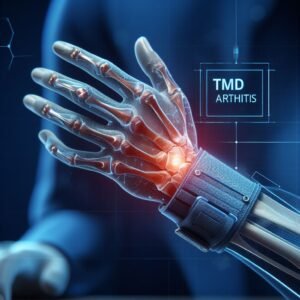The human body is a complex web of interconnected systems, and sometimes seemingly unrelated health issues can have surprising connections. Temporomandibular Disorder (TMD) and arthritis are two such conditions that, at first glance, appear to have little in common. TMD affects the jaw joint, while arthritis encompasses a range of joint-related disorders affecting various parts of the body. However, emerging research suggests there might be more to their relationship than meets the eye. In this article, we will explore the intriguing question: Is TMD related to arthritis? Let’s uncover the science behind this potential link.
Key Takeaways
- TMD and arthritis are both conditions that affect the jaw joint and surrounding muscles.
- TMD can be a symptom of arthritis, particularly rheumatoid arthritis.
- TMD can worsen the symptoms of arthritis, leading to increased pain and discomfort.
- Both TMD and arthritis can cause symptoms such as jaw pain, joint inflammation, difficulty in mouth movement, and impact on daily activities like talking, eating, and sleeping comfortably.

Understanding TMD and Arthritis
You’ll understand the relationship between TMD and arthritis better by exploring their connection and impact on each other.
Temporomandibular joint disorder (TMD) refers to a condition affecting the jaw joint and the surrounding muscles. It can cause pain, difficulty in opening and closing the mouth, and even clicking or popping sounds.
On the other hand, arthritis is a broader term encompassing various conditions that cause joint inflammation and pain.
The link between TMD and arthritis lies in the fact that both conditions affect the joints. In some cases, TMD can actually be a symptom of arthritis, particularly rheumatoid arthritis. In other instances, TMD can worsen the symptoms of arthritis, leading to increased pain and discomfort in the jaw joint and surrounding areas.
Understanding this connection is crucial for effective management and treatment of both conditions.
Common Symptoms of TMD and Arthritis
Experiencing jaw pain and joint inflammation are common symptoms of both TMD and arthritis. If you’re dealing with temporomandibular disorder (TMD), you may find yourself experiencing discomfort and tenderness in your jaw joint and the surrounding muscles. This can make it difficult to open your mouth fully or chew your food properly.
Similarly, if you have arthritis, you may also experience pain, swelling, and stiffness in your joints, including the temporomandibular joint. These symptoms can impact your ability to talk, eat, and even sleep comfortably.
Understanding the common symptoms of both TMD and arthritis is crucial in determining the best course of treatment. Now, let’s delve into the potential causes of TMD and arthritis.
Potential Causes of TMD and Arthritis
When considering the potential causes of TMD and arthritis, it’s important to understand the underlying factors that contribute to these conditions.
TMD, or temporomandibular disorder, can be caused by a variety of factors, including jaw injuries, misalignment of the teeth and jaw, stress, and teeth grinding.
Arthritis, on the other hand, is often caused by a combination of genetic and environmental factors, such as age, gender, obesity, and joint injuries.
It’s believed that both TMD and arthritis share similar risk factors, such as age and joint injuries, which could explain the potential link between the two conditions.
Understanding these potential causes can help healthcare professionals diagnose and treat TMD and arthritis effectively.
Moving forward, let’s explore the diagnostic methods for these conditions.
Diagnosing TMD and Arthritis
To diagnose TMD and arthritis, your healthcare professional will use various methods to evaluate your symptoms and assess the condition of your jaw and joints.
The first step is a thorough medical history and physical examination. Your doctor will ask you about your symptoms, such as pain, stiffness, and difficulty in opening or closing your mouth. They’ll also examine your jaw joints, looking for signs of inflammation, tenderness, or deformity.
Additionally, imaging tests may be ordered, such as X-rays, CT scans, or MRI scans, to get a clearer picture of the joint structures and any damage or abnormalities present.
These diagnostic tools help your healthcare professional determine if you have TMD, arthritis, or a combination of both, and develop an appropriate treatment plan.
Treatment Options for TMD and Arthritis
After diagnosing TMD and arthritis, your healthcare professional will discuss various treatment options to alleviate your symptoms and manage the conditions. Here are some options to consider:
- Medications: Your doctor may prescribe pain relievers, muscle relaxants, or anti-inflammatory drugs to reduce pain and inflammation.
- Physical therapy: Through exercises and techniques, physical therapy can help improve jaw function, reduce pain, and increase jaw mobility.
- Oral appliances: Wearing a splint or mouthguard can provide relief by reducing pressure on the jaw joint and preventing teeth grinding or clenching.
- Lifestyle changes: Making certain modifications like eating soft foods, avoiding chewy or hard foods, and practicing stress management techniques can help ease symptoms.
- Surgery: In severe cases, surgery may be recommended to repair or replace the jaw joint.
Remember to consult with your healthcare professional to determine the best treatment plan for your specific situation.
Conclusion
In conclusion, TMD (temporomandibular disorder) and arthritis are related conditions that can share common symptoms and potential causes. They both affect the joints and can cause pain and discomfort.
However, proper diagnosis is crucial to determine the specific condition and appropriate treatment options. Seeking medical advice and exploring various treatment options can help manage the symptoms and improve overall quality of life for individuals with TMD and arthritis.

Mr. Mark Rogers is independent health investigator with over 25+ years of experience. He’s also a father and past TMJ sufferer. He’s explored numerous treatment options and found the most lasting relief from Neuromuscular Release Therapy. His passions include biohacking, cycling, and spending time with his family. He’s based out of beautiful Atlanta, Georgia. You can find him on his social profiles below.